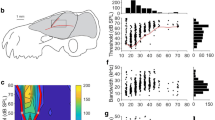Summary
-
1.
Within the tonotopic organization of the inferior colliculus two frequency ranges are well represented: a frequency range within that of the echolocation signals from 50 to 100 kHz, and a frequency band below that of the echolocation sounds, from 10 to 35 kHz. The frequency range between these two bands, from about 40 to 50 kHz is distinctly underrepresented (Fig. 3B).
-
2.
Units with BFs in the lower frequency range (10–25 kHz) were most sensitive with thresholds of -5 to -11 dB SPL, and units with BFs within the frequency range of the echolocation signals had minimal thresholds around 0 dB SPL (Fig. 1).
-
3.
In the medial part of the rostral inferior colliculus units were encountered which preferentially or exclusively responded to noise stimuli. — Seven neurons were found which were only excited by human breathing noises and not by pure tones, frequency modulated signals or various noise bands. These neurons were considered as a subspeciality of the larger sample of noise-sensitive neurons. — The maximal auditory sensitivity in the frequency range below that of echolocation, and the conspicuous existence of noise and breathing-noise sensitive units in the inferior colliculus are discussed in context with the foraging behavior of vampire bats.
Similar content being viewed by others
Abbreviations
- BF :
-
Best frequency
- IC :
-
inferior colliculus
References
Aitkin LM, Fryman S, Blake DW, Webster WR (1972) Responses of neurones in the rabbit inferior colliculus. I. Frequency specificity and topographic arrangement. Brain Res 47:77–90
Aitkin LM, Irvine DRF, Nelson JE, Merzenich MM, Clarey JC (1986) Frequency representation in the auditory midbrain and forebrain of a marsupial, the northern native cat, Dasiurus hallucatus. Brain Behav Evol 29:17–28
Bell GP (1982) Behavioral and ecological aspects of gleaning by the desert insectivorous bat Antrozous pallidus (Chiroptera: Vespertilionidae). Behav Ecol Sociobiol 10:217–223
Buchler ER, Childs SB (1981) Orientation to distant sounds by foraging big brown bats (Eptesicusfuscus). Anim Behav 29:428–432
Evans EF, Whitfield IC (1964) Classification of unit responses in the auditory cortex of the unanesthetized and unrestrained cat. J Physiol 179:476–493
Fiedler J (1979) Prey catching with and without echolocation in the Indian false vampire bat (Megaderma lyra). Behav Ecol Sociobiol 6:155–160
Greenhall AM, Schmidt U (eds) (1988) Natural history of vampire bats. CRC Press, Boca Raton
Guppy A, Coles RB (1988) Acoustical and neural aspects of hearing in the Australian gleaning bats, Macroderma gigas and Nyctophilus goutdi. J Comp Physiol A 162:653–668
Joermann G, Schmidt U (1981) Echoortung bei der Vampirfledermaus, Desmodus rotundus. II. Lautaussendung im Flug und Korrelation zum Flügelschlag. Z Säugetierkunde 46:136–146
Marimuthu G, Neuweiler G (1987) The use of acoustical cues for prey detection by the Indian false vampire bat, Megaderma lyra. J Comp Physiol A 166:509–515
Møller A (1982) Use of pseudorandom noise in studies of the dynamic properties of the linear part of a sensory neural system. Proc 15th Inter Conf Syst Sci 2:337–351
Neuweiler G (1990) Auditory adaptations for prey capture in echolocating bats. Physiol Rev 70:615–641
Payne RS (1971) Acoustic location of prey by barn owls. J Exp Biol 54:535–573
Pollak GD, Schuller G (1981) Tonotopic organization and encoding features of single units in the inferior colliculus of horseshoe bats: functional implications for prey identification. J Neurophysiol 45:208–226
Rockel AJ, Jones EG (1973) The neuronal organization of the inferior colliculus of the adult cat. I. The central nucleus. J Comp Neurol 147:11–60
Rübsamen R, Neuweiler G, Sripathi K (1988) Comparative collicular tonotopy in two bat species adapted to movement detection, Hipposideros speoris and Megaderma lyra. J Comp Physiol A 163:271–285
Schlegel P, Jen P, Singh S (1988) Auditory spatial sensitivity of inferior collicular neurons of echolocating bats. Brain Res 456:127–138
Schmidt U (1978) Vampirfledermäuse. A. Ziemsen, Wittenberg Lutherstadt
Schmidt U (1988) Orientation and sensory functions in Desmodus rotundus. In: Greenhall AM, Schmidt U (eds) Natural history of vampire bats. CRC Press, Boca Raton, pp 143–166
Schnitzler H-U, Menne D, Kober R, Heblich K (1983) The acoustical image of fluttering insects in echolocating bats. In: Huber F, Markl H (eds) Neuroethology and behavioral physiology. Roots and growing points. Springer, Berlin, Heidelberg, New York, pp 235–250
Stiebler I, Ehret G (1985) Inferior colliculus of the house mouse. I. A quantitative study of tonotopic organization, frequency representation, and tone-threshold distribution. J Comp Neurol 238:65–76
Suga N (1969) Classification of inferior collicular neurones of bats in terms of responses to pure tones, FM sounds and noise bursts. J Physiol 200:555–574
Vernon J, Peterson E (1966) Hearing in the vampire bats, Desmodus rotundus murinus, as shown by cochlear potentials. J Audit Res 6:181–187
Author information
Authors and Affiliations
Rights and permissions
About this article
Cite this article
Schmidt, U., Schlegel, P., Schweizer, H. et al. Audition in vampire bats, Desmodus rotundus . J Comp Physiol A 168, 45–51 (1991). https://doi.org/10.1007/BF00217102
Accepted:
Issue Date:
DOI: https://doi.org/10.1007/BF00217102




